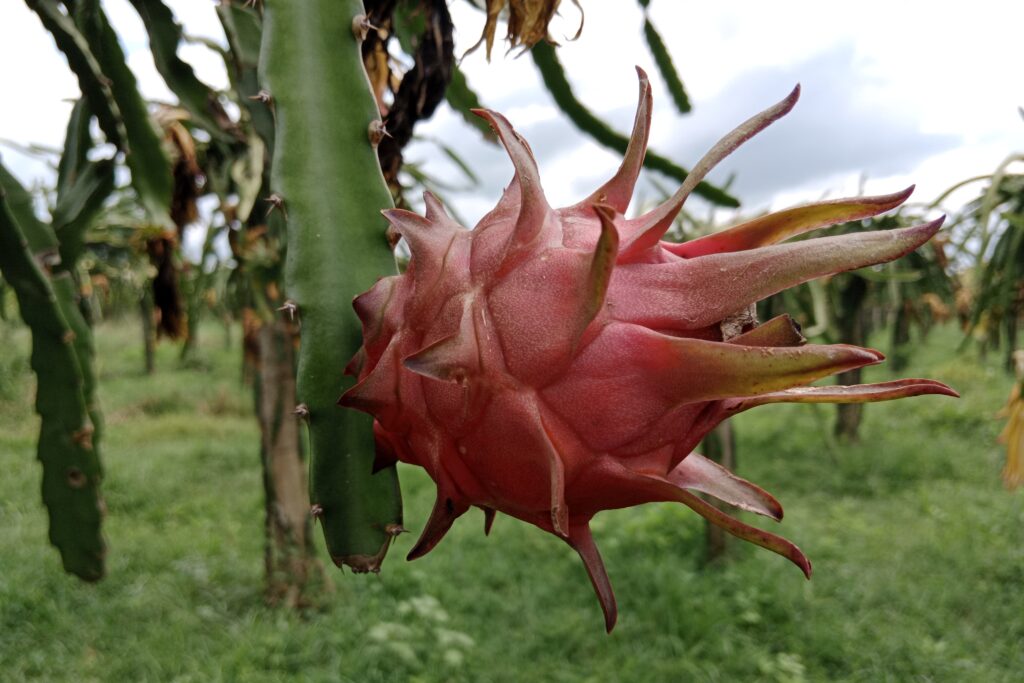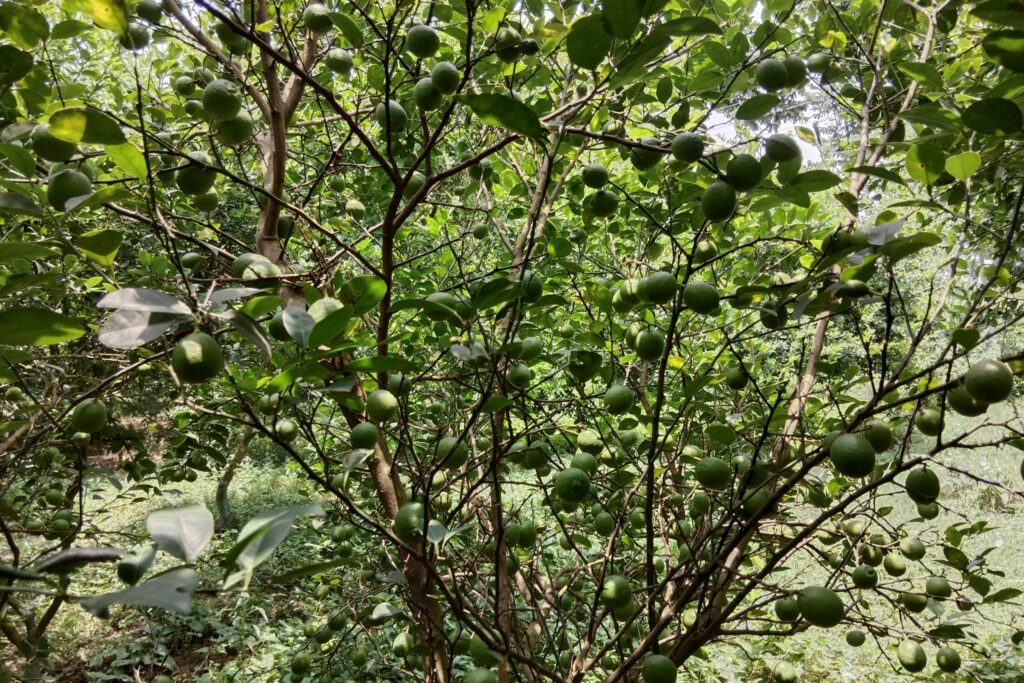Marigold Farming
In marigold farming, profitability can vary significantly depending on the variety cultivated. For African Marigold, the total income generated per acre is NRs 240,000, compared to a total investment of NRs 46,000. This results in a net profit of NRs 194,000 and a remarkable profit margin of approximately 422%. On the other hand, French Marigold farming yields a total income of NRs 210,000 per acre with the same level of investment (NRs 46,000).
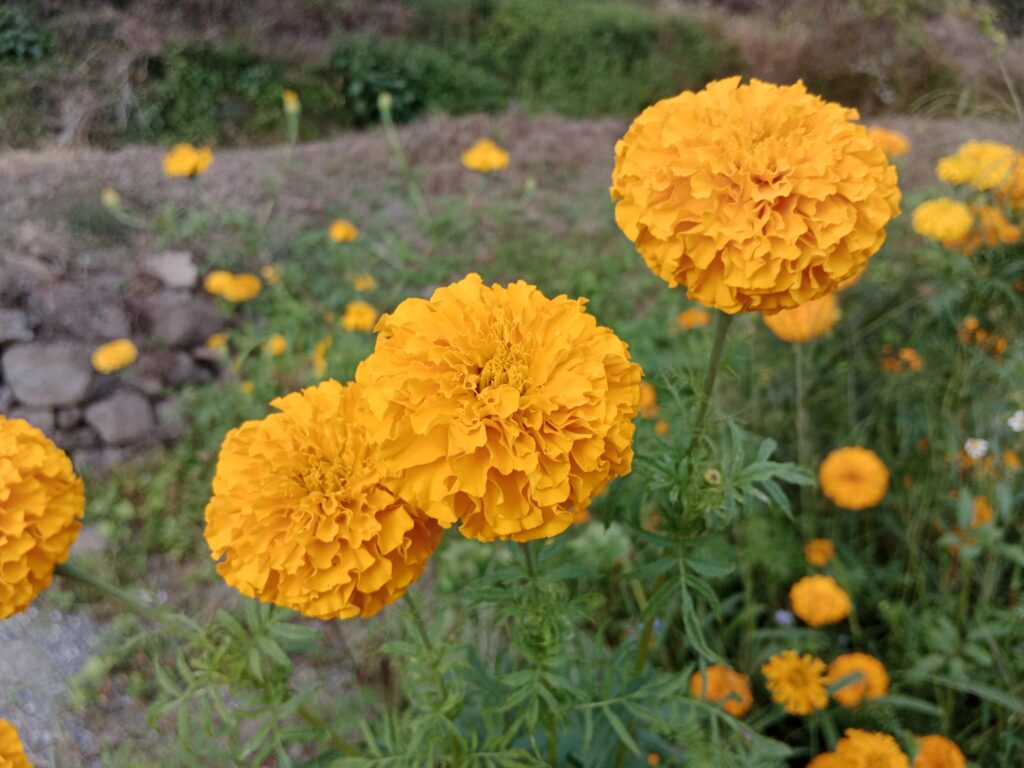
This translates to a net profit of NRs 164,000 and a profit margin of about 356%. These figures clearly demonstrate that marigold farming profit per acre is significantly higher for the African variety, making it a more lucrative option for farmers.
Land Preparation
Land preparation begins with initial deep ploughing (20-25 cm) using a mouldboard plough, ideally conducted right after the previous crop is harvested or during the summer months (April-May), to expose soil pests and weeds to sunlight. This is followed by performing 2-3 cross harrowings to break down soil clods and meticulously leveling the field, ensuring uniform irrigation and preventing waterlogging.
During the last harrowing pass, 15-20 tonnes of well-rotted Farmyard Manure (FYM) or compost per hectare is incorporated into the soil to enhance its structure, water retention capacity, and fertility. Finally, raised beds (15-20 cm in height and 1-1.2m in width) are formed to improve drainage, particularly crucial in heavy soil or high rainfall areas, with furrows left between the beds to facilitate irrigation and movement within the field.
Soil Type
Deep, rich, well-drained loamy or sandy loam soils are ideal for marigold growth. Although it can tolerate a fairly broad pH range, the ideal soil pH range for good nutrient availability is between 6.0 and 7.5, which is slightly acidic to neutral. Furthermore, marigolds are extremely vulnerable to waterlogging damage, so it is imperative that they have excellent drainage. Heavy clay soils should be avoided unless exceptional drainage can be ensured, and saline or extremely alkaline soils are completely unsuitable for successful cultivation.
Climatic Requirements
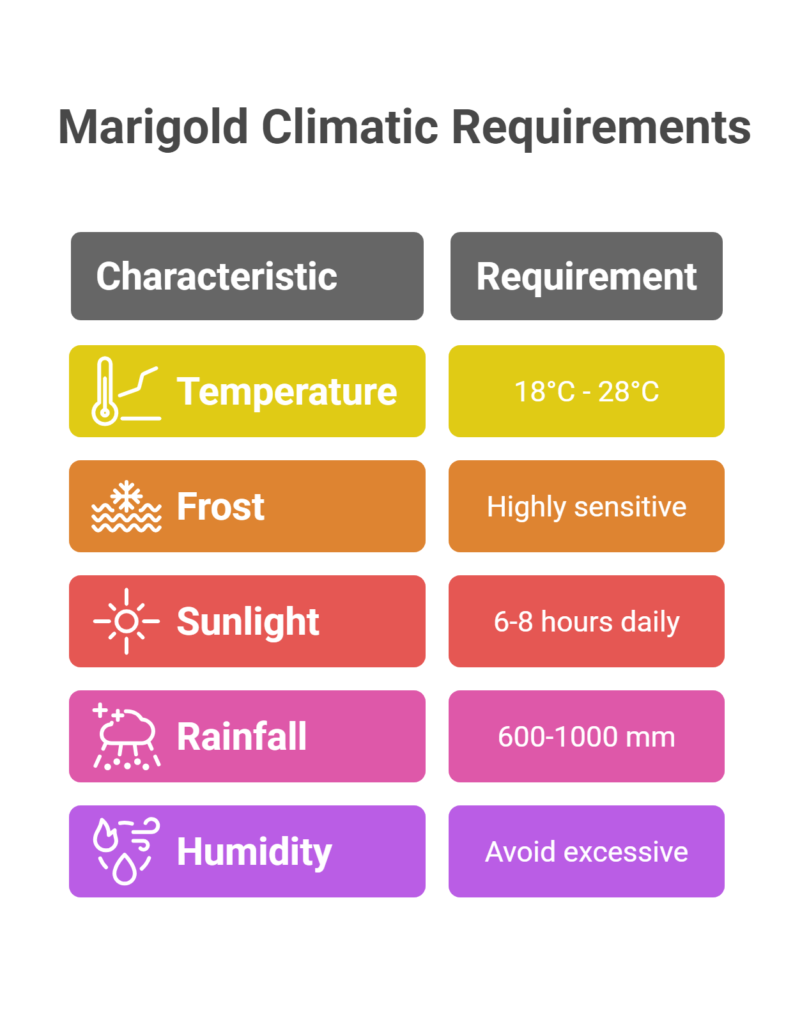
As a warm-season crop, marigolds require optimal temperatures between 18°C and 28°C for best growth and are highly sensitive to frost, making cultivation impossible during freezing conditions. They demand full sunlight, receiving at least 6 to 8 hours daily, as insufficient light significantly reduces both the quantity and quality of blooms. While preferring moderate annual rainfall (600-1000 mm), excessive rain or humidity promotes fungal diseases, necessitating irrigation during drier periods; crucially, high humidity during the flowering stage can lead to damaging bud rot.
Major Cultivars
| Type | Description | Varieties |
| African Marigold | Tall plants (60–90 cm) with large flowers in lemon, yellow, golden yellow, orange, or bright yellow colors. A long-duration variety. | Giant Double African Orange, Crown of Gold, Giant Double African Yellow, Chrysanthemum Charm, Golden Age, Cracker Jack |
| French Marigold | Early maturing dwarf varieties with small flowers in colors ranging from yellow, orange, golden yellow, rusty red, mahogany, etc. | Rusty Red, Butter Scotch, Red Borcade, Star of India, Lemon Drop |
| Pusa Basanti Gainda | Long-duration variety with plants approximately 58.80 cm tall. Dark green leaves and sulphur yellow, double, carnation-type flowers. | – |
| Pusa Narangi Gainda | Takes 125–136 days for flowering. Plants are tall (73.30 cm) with dark green leaves. Flowers are orange, compact, and double-layered. Yields about 140 quintals per acre of fresh flowers. | – |
Seed Rate
The recommended seed rate for marigold cultivation is 600 grams per acre when sowing seeds directly.
Nursery Bed Preparation
Prepare a nursery bed of 3m x 1m size by leveling the soil and enriching it with well-decomposed cow dung manure. Irrigate the bed thoroughly to keep it moist but not waterlogged. Crush well-dried flowers and broadcast the seeds evenly over the bed or sow them in lines with proper spacing.
Maintain consistent moisture levels and protect the bed from extreme weather conditions using shade nets if necessary. Regularly water the bed to support germination and seedling growth. After approximately four weeks, when the seedlings reach a height of 10-15 cm, they are ready for transplantation. Carefully uproot the seedlings without damaging the roots and transplant them into the main field, watering them immediately to ensure proper establishment.
Planting
a). Planting Season
The planting season for marigolds varies by region. In plains, the main seasons are Kharif (with planting in June-July and flowering from August to October) and Summer (with planting in January-February and flowering from March to May), while Rabi planting is possible in frost-free areas during October-November. In hilly regions, planting is typically done in Spring (March-April) and Summer (May-June).

b). Spacing
African Marigold: 45 cm (Row to Row) x 45 cm (Plant to Plant)
French Marigold: 35 cm (Row to Row) x 35 cm (Plant to Plant)
Adjust based on cultivar vigor and soil fertility. Wider spacing improves air circulation and reduces disease.
c). Pit Preparation:
Dig pits of 15 cm x 15 cm x 15 cm at recommended spacing. Mix topsoil with 100-200g of well-decomposed FYM/compost and a handful of neem cake (for pest deterrence) before filling back.
d). Planting Method
The most common planting method is seedling transplanting: seedlings are first raised in nursery beds, and when they develop 4-6 true leaves and reach a height of 10-15 cm, healthy ones are transplanted into prepared fields during the cooler parts of the day, typically in the evening; water is applied immediately after transplanting to reduce transplanting shock.
e). Number of Plants per Acre:
African Marigold: ~20,000 plants (45cm x 45cm spacing)
French Marigold: ~33,000 plants (35cm x 35cm spacing)
Intercropping
Marigolds are an excellent and feasible intercropping partner due to their pest-repellent properties, particularly against nematodes and certain insects; suitable companion crops include short-duration vegetables such as radish, carrot, onion, and leafy greens, which should be grown only during their initial stage before the marigold canopy closes.
However, dense, tall crops that shade the marigolds should be avoided. For layout, plant the intercrops in separate rows between the marigold rows, ensuring adequate spacing is maintained for both crops, and cease intercropping before the marigold flowering stage to prevent competition.
Irrigation
Irrigation is critical during transplanting, flowering initiation, and peak flowering stages; initially water every 3-4 days until plants establish, then irrigate weekly depending on soil and weather, avoiding water stress especially during bud formation and flowering.
Common methods include furrow irrigation, while drip irrigation is highly efficient for water saving and reducing foliar diseases; sprinklers can be used but should be avoided during flowering to prevent petal damage and disease. The key is maintaining moderate soil moisture, avoiding both overwatering (which causes waterlogging and root rot) and prolonged dry spells (which reduce flower size and yield).
FERTILIZER AND MANURE
| Application Stage | Material | Quantity per Acre | Timing / Method | Notes |
| Basal Dose | Well-decomposed FYM/Compost | 8-10 tonnes | At planting | Mix thoroughly into soil during final land preparation. |
| Nitrogen (N) | 40-50 kg (e.g., 110 kg Urea) | |||
| Phosphorus (P₂O₅) | 60-80 kg (e.g., 375 kg SSP) | |||
| Potassium (K₂O) | 40-50 kg (e.g., 80 kg MOP) | |||
| Top Dressing | Remaining Nitrogen (N) | 40-50 kg | In 2-3 split doses, starting 3-4 weeks after transplanting, at 3-week intervals. | Stop application before full bloom. |
| Micronutrients | Zinc (as ZnSO₄) | 0.5% foliar spray solution | Apply as foliar spray at bud initiation stage. | Use if deficiencies suspected. Improves flower quality & yield. |
| Boron (as Borax) | 0.1% foliar spray solution |
Weed Control
The critical period for weed control is the first 40-50 days after transplanting; methods include mechanical control through 2-3 shallow hoeings (3-4 cm deep) – starting 20-25 days post-transplanting, followed by subsequent hoeings at 15-day intervals, while carefully avoiding root damage; mulching with organic materials like paddy straw or dried leaves, or black plastic mulch (which effectively suppresses weeds and conserves moisture); and chemical control using pre-emergence herbicides such as Pendimethalin (1.0-1.5 kg a.i./ha) or Oxyfluorfen (0.15-0.2 kg a.i./ha), applied immediately after transplanting on moist soil, though these must be used with caution adhering strictly to label instructions, with any escaped weeds removed by hand later.
Pest and Disease Management
Common Pests
a). Aphids & Thrips
Suck sap, distort growth. Control: Spray Imidacloprid (0.3 ml/l) or Acetamiprid (0.2 g/l) or Neem oil (2-3 ml/l).
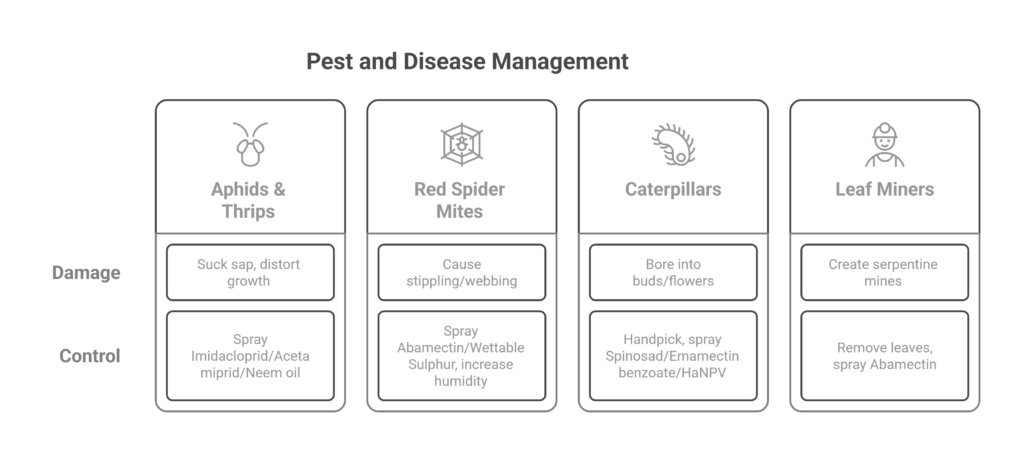
b). Red Spider Mites
Cause stippling/webbing, especially in hot/dry weather. Control: Spray Abamectin (0.5 ml/l) or Wettable Sulphur (2g/l) or increase humidity.
c). Caterpillars (Helicoverpa, Spodoptera)
Bore into buds/flowers. Control: Handpick, spray Spinosad (0.3 ml/l) or Emamectin benzoate (0.25 g/l) or HaNPV.
d). Leaf Miners
Create serpentine mines. Control: Remove affected leaves, spray Abamectin.
Common Diseases
a). Damping Off (Nursery)
Prevent well-drained soil, avoid overcrowding, drench with Trichoderma viride/Bordeaux mixture/Captan.
b). Flower Bud Rot (Botrytis)
Grey mold in humid conditions. Control: Improve air circulation, avoid overhead irrigation, spray Carbendazim (1g/l) or Azoxystrobin (0.5-1 ml/l).
c). Powdery Mildew
White powdery growth on leaves. Control: Spray Wettable Sulphur (2g/l) or Dinocap (1ml/l) or Hexaconazole (0.5 ml/l).
d). Alternaria Leaf Spot
Brown spots with concentric rings. Control: Remove infected leaves, spray Mancozeb (2g/l) or Azoxystrobin.
e). Root Rot/Wilt (Phytophthora/Fusarium)
Wilting, root decay. Control: Ensure drainage, drench soil with Copper oxychloride (3g/l) or Metalaxyl+Mancozeb. Crop rotation is essential.
Harvesting
Marigold flowers are harvested at different stages depending on their intended use: for loose flowers (garlands, decorations), harvest when fully open with firm petals, typically 60-75 days after planting for African varieties and 45-60 days for French varieties, preferably during cool morning hours; for extraction or pigments, harvest at full bloom; for cut flowers, harvest buds showing color but just starting to open (tight stage) to maximize vase life. Gently twist flowers or use secateurs to pick them with the calyx intact to prevent shattering, avoiding bruising. Harvest every 3-5 days during peak season, as regular picking encourages further flowering.
Yield
African Marigold: 8-12 tonnes fresh flowers/acre.
French Marigold: 5-8 tonnes fresh flowers/acre.
Yield varies significantly with cultivar, season, and management practices.
Post-Harvest
Immediately after harvesting, marigold flowers must be kept in the shade to prevent wilting and quality deterioration; they should then be sorted and graded based on size and color uniformity, bundled into manageable lots (typically 50-100 flowers per bundle), and packed loosely in well-ventilated containers like bamboo baskets or crates lined with moist packing material (such as damp paper or cloth) to maintain humidity during transport.
Due to their highly perishable nature, marigolds have a very short post-harvest life—lasting only 2-3 days at room temperature—though this can be extended slightly by storing them at cool temperatures of 4–6°C (39–43°F) to reduce respiration and decay.
Cost of Investment for Marigold Farming per Acre
| S.N. | Category | Cost (NRs) |
| 1 | Land Preparation | 15,000 |
| 2 | Seed Rate | 5,000 |
| 3 | Transplanting Labor | 3,000 |
| 4 | Fertilizers & Manure | 7,000 |
| 5 | Irrigation | 4,000 |
| 6 | Weed Control | 2,000 |
| 7 | Pest & Disease Control | 5,000 |
| 8 | Harvesting | 2,000 |
| 9 | Miscellaneous Costs | 3,000 |
| Total Investment | 46,000 |
Income from Marigold Farming Per Acre
| Variety | Yield (kg) | Price/kg (NRs) | Total Income (NRs) |
| African Marigold | 8,000 | 30 | 240,000 |
| French Marigold | 7,000 | 30 | 210,000 |
Analysis of Marigold Farming Profit Per Acre
For African Marigold, the total income is NRs 240,000 against a total investment of NRs 46,000, yielding a net profit of NRs 194,000 and a profit margin of approximately 422%. For French Marigold, the total income is NRs 210,000 with the same investment (NRs 46,000), resulting in a net profit of NRs 164,000 and a profit margin of roughly 356%, indicating significantly higher profitability for the African variety.

